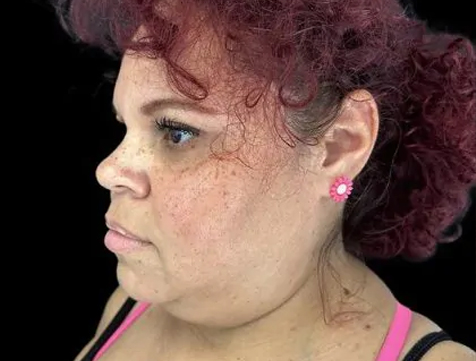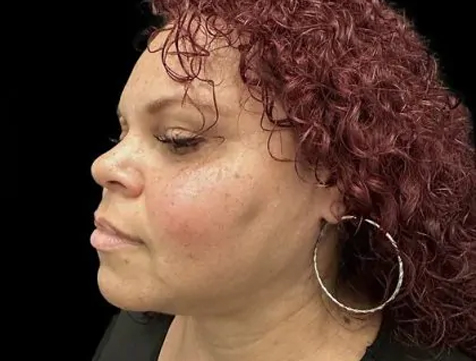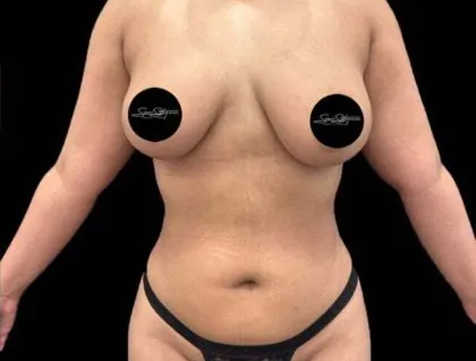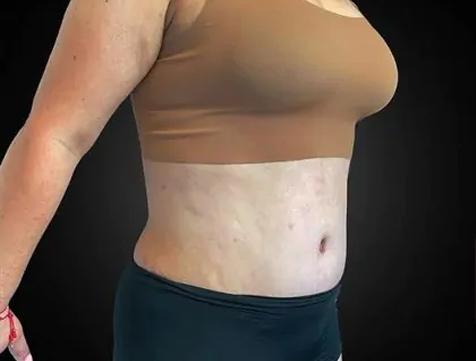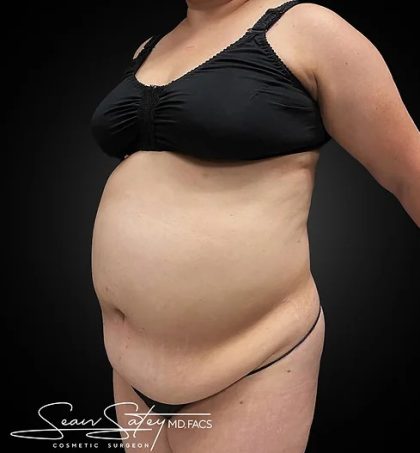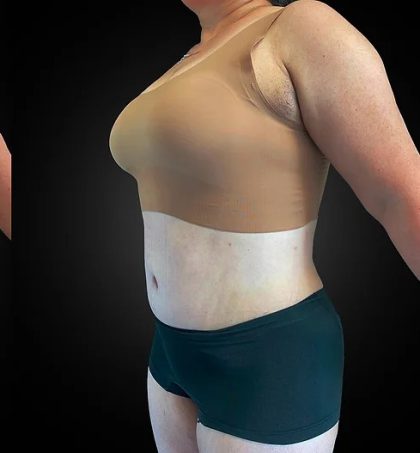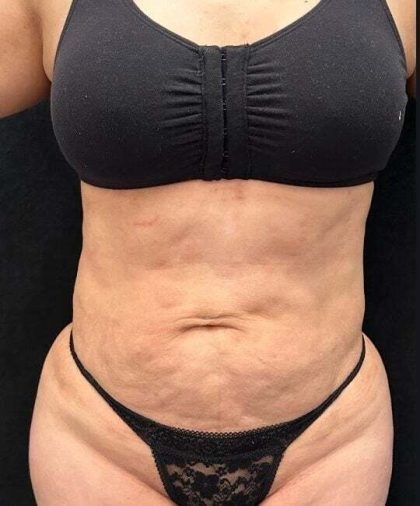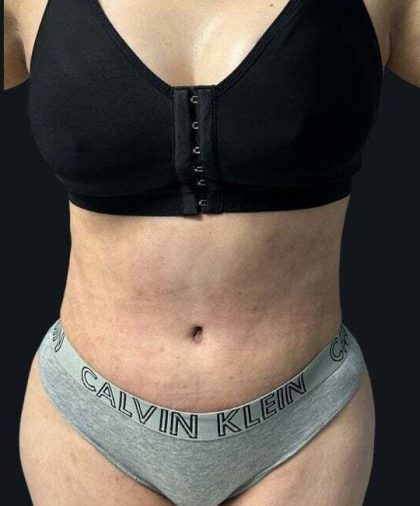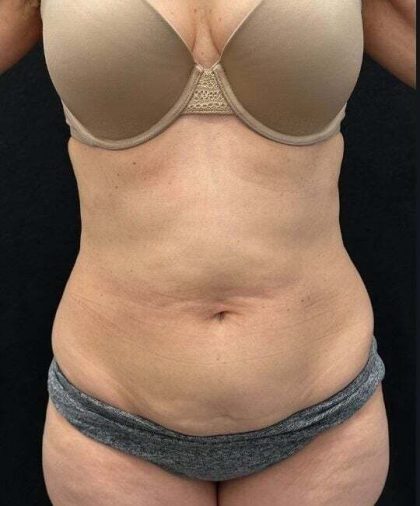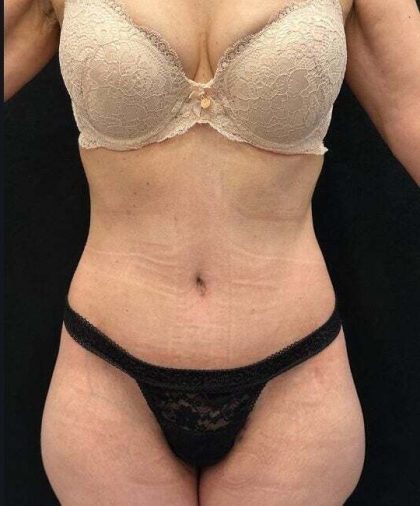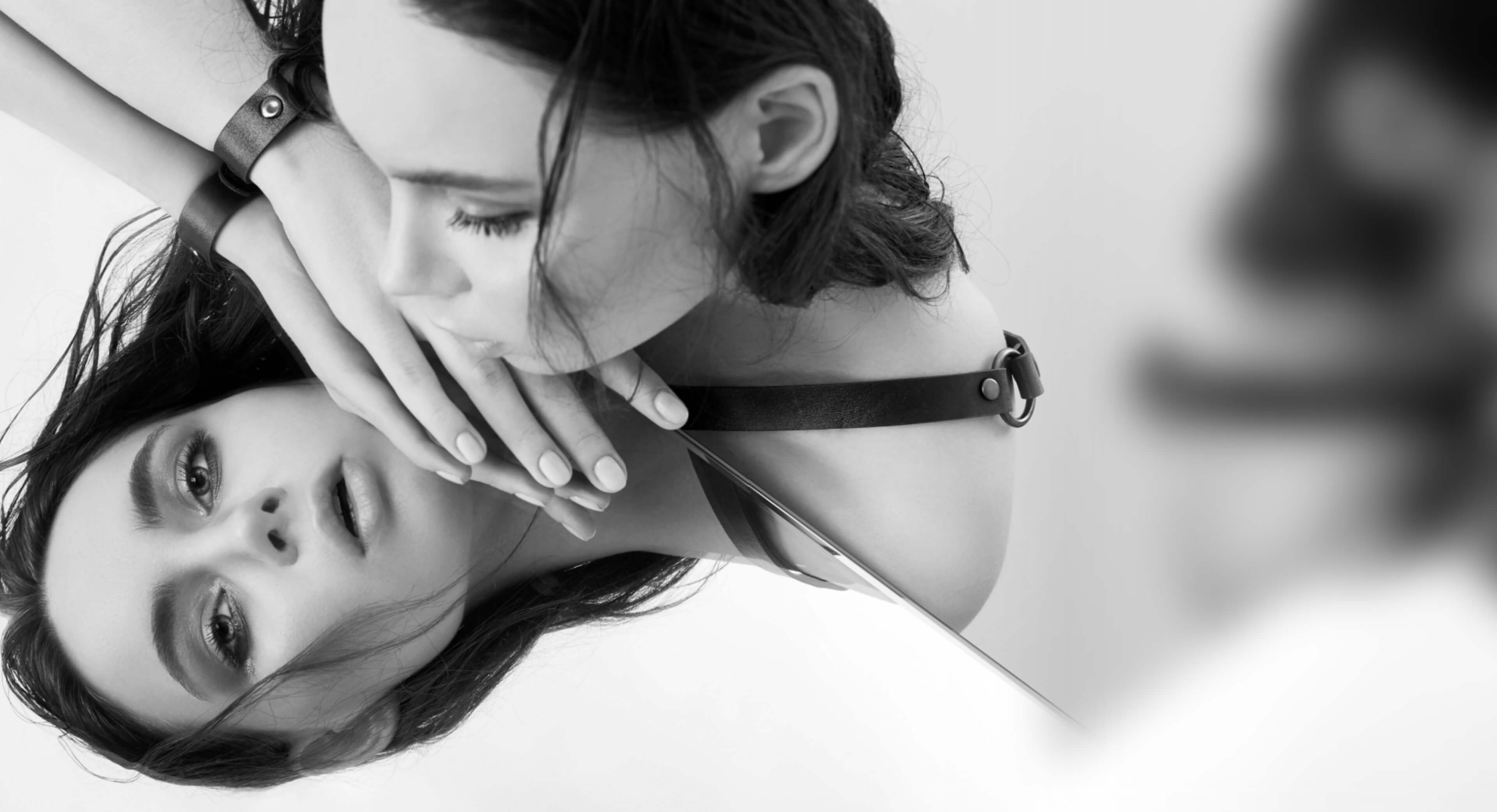Tummy Tuck
Consultations offered at our two convenient locations in Lancaster and Los Angeles, CA

A tummy tuck, also known as an abdominoplasty, is a procedure designed to remove excess fat and skin from the abdomen and create a beautiful innie belly button. This procedure can help create a more sculpted figure, as well as tighten and strengthen the abdominal muscles. Drooping tissue can be caused by factors such as aging, genetics, weight fluctuations, post-bariatric surgery weight loss, and after achieving weight loss with GLP-1 medications like semaglutide or tirzepatide. Additionally, pregnancy or weight gain can cause the abdominal muscles to weaken or separate, also known as a condition called diastasis recti. (1)
Dr. Sean Satey is a board-certified general and fellowship-trained cosmetic surgeon based in Los Angeles and Lancaster, California. He completed a rigorous, five-year general surgery residency, after which he received his board certification, which he continues to maintain. This was followed by a cosmetic surgery fellowship through the American Academy of Cosmetic Surgery. Internationally recognized, he is renowned for his body-contouring expertise, published work, and ability to create stunning results.
To schedule your consultation with Dr. Satey at either one of our Southern California offices, please call (424) 500-3320 or contact us online.
Contents
Before and After Photos
About Tummy Tucks
A tummy tuck is designed to help reshape and contour the abdomen by removing excess fat and skin. This procedure can be used to create a smoother, more toned silhouette, as well as to tighten and repair their core muscles, which act like an internal corset. Dr. Satey can achieve this by performing either a full tummy tuck or a mini tummy tuck.
Full/Traditional Tummy Tuck
A traditional or full tummy tuck addresses loose skin both above and below the belly button. This variation is commonly performed on patients interested in addressing changes such as muscle weakness and separation. Dr. Satey also creates his signature new, aesthetically pleasing innie belly button during this procedure. By cinching the waist internally, like a corset, muscle repair can help provide patients with a slender, “snatched” appearance in the midsection. This procedure involves a low-set incision above the pubic area that can easily be hidden under clothing.
Mini Tummy Tuck
A mini tummy tuck is a variation of the full tummy tuck that only addresses the skin below the navel. This technique is often used for patients with less tissue to remove, as it does not address muscle separation or loose skin in the upper abdomen. Additionally, the mini tummy tuck does not involve new innie belly button construction like the full tummy tuck does, and the incision length may be similar to that of the more extensive procedure. Dr. Satey will determine the best methods and strategies to use after evaluating each patient at their consultation.
Tummy Tuck Benefits
Patients can experience a myriad of benefits after undergoing a tummy tuck, including:
- Flatter Abdomen: After any excess tissue or skin is removed, patients will be able to enjoy a smoother, more toned-looking abdomen.
- Tightened Muscles: Dr. Satey can help reposition, tighten, and strengthen any abdominal muscles that may have become loose or separated.
- Creation of Dr. Satey’s signature Innie Belly Button: When performing a full tummy tuck, Dr. Satey constructs his signature innie belly button. This leaves patients with a more proportionate and overall more aesthetic-looking navel.
- Improved Figure: A tummy tuck can leave patients with a more defined waistline and proportionate silhouette.
- Enhanced Confidence: Many patients may experience an improvement in their self-esteem and confidence after seeing their new contours.
- Reduced Stretch Marks: Individuals may see a reduction in stretch marks, most notably below the navel, depending on how much skin is removed.
- Long-Lasting Results: As long as a healthy lifestyle is maintained, the results of a tummy tuck can last for several years.
To find out how you may benefit from a tummy tuck, please call (424) 500-3320 or contact us online.
Ideal Candidates
The ideal candidates for a tummy tuck include those with excess skin around the midsection and loose abdominal muscles caused by weight gain or pregnancy. Women who have recently recovered from pregnancy are welcome to consider this procedure, but should have completed planning their family, as another pregnancy can alter the results. Patients should be at a stable, maintainable weight before undergoing a tummy tuck. (2)
Individuals interested in our tummy tuck procedure should be in good overall health, free from any underlying medical conditions that may impair healing. They should also have realistic expectations regarding the procedure’s outcome. Dr. Satey will determine each patient’s candidacy at their consultation.
Personal Consultation
Each patient is asked to attend a personal consultation at either our Los Angeles or Lancaster office before their tummy-tuck appointment. We also offer virtual consultations for out-of-town and international patients.
This consultation is not only an opportunity for Dr. Satey to meet each patient but also to understand how he can best help them achieve their goals. He will first examine each patient’s physical condition before learning more about their medical history, concerns, and ideal aesthetic. After determining their candidacy, he will craft each patient’s procedure, selecting the best surgical strategies to help address their concerns. Pre- and post-operative instructions will then be provided, as well as a price quote. Each patient is encouraged to ask questions, as we want to ensure they feel informed and empowered before their tummy tuck.
To schedule your in-person or virtual consultation, please call (424) 500-3320 or contact us online.
Preparation
In preparation for their tummy tuck, patients will need to undergo lab testing to ensure they are in good health and physically ready. Each patient will receive a set of pre-operative instructions at their consultation to help them properly prepare for their tummy tuck. Instruction may vary between patients depending on the details of their procedure, as well as their lifestyle habits.
Patients may be asked to temporarily avoid the use of certain medications and supplements, specifically those containing blood-thinning properties, as well as the consumption of alcohol. Those who smoke will also need to cease their use at least three months before their appointment, as nicotine, tobacco, and cannabis can inhibit healing.
Logistically, patients will need to arrange for transportation home from either their procedure or aftercare facility, as well as time away from work and other social commitments. Many patients may also find it helpful to arrange for assistance around the house during their initial healing period.
Procedure
Dr. Satey will begin each tummy tuck by carefully marking out the treatment area with a skin-safe marker before cleansing and sterilizing the skin. General anesthesia will be administered to each patient to ensure they feel comfortable throughout the procedure.
Full/Traditional Tummy Tuck
Dr. Satey will make a low-set incision from hip to hip, just above the pubic area. This placement ensures that any scarring can easily be hidden under clothing. He will then remove excess skin, fat, and tissue to help create a slimmer, flatter, and smoother torso. To “snatch” the waist, he will internally suture the abdominal muscles, effectively repairing diastasis recti, or the separation of the abdominal muscles. Using his signature methods, Dr. Satey will create a new innie belly button that complements the patient’s new figure. (3)
Mini Tummy Tuck
The mini tummy tuck procedure begins similarly to the full tummy tuck, with an incision being placed from hip to hip, near the pubic area. However, the mini tummy tuck does not address diastasis recti or other weakened muscles, or result in the creation of a new navel like the full tuck, as this technique is primarily reserved for less extensive corrections. Dr. Satey will remove any excess tissue and fat from the area before repositioning the skin and closing the incisions.
Recovery
If necessary, patients may be transported to an aftercare facility after their tummy tuck, where professionals monitor patients’ health and ensure their well-being. The aftercare facility is staffed with talented nurses who can help care for each individual and facilitate a smooth transition back to their home. Patients can expect their stay to be 24 hours long or just the night of surgery.
Once transported home, patients are encouraged to walk around the house to reduce the risk of clots and to improve their circulation.
It is common to experience discomfort or soreness during recovery, but these effects may be managed with the use of prescribed medication under the guidance of Dr. Satey. Patients can typically return to work within two weeks but should continue avoiding physical activities and strenuous tasks for several weeks. Drains will also be placed to help prevent the buildup of fluid under the skin. Any further recovery guidelines will be given to each patient by Dr. Satey during their personal consultation.
Results
Following a tummy tuck, patients will be able to enjoy a slimmer, flatter, and more toned abdomen. Additionally, patients will be able to notice a more defined waistline and desirable silhouette. Many women also report an increased sense of self-esteem and confidence.
The results of a tummy tuck are long-lasting, with patients experiencing their results for years, however, it is important to maintain healthy lifestyle habits as fluctuations in weight, as well as pregnancy, can alter the results. Over time, any scarring will continue to fade–especially with Dr. Satey’s scar refinement program–and can easily be concealed by clothing. Tummy tucks are associated with a high patient satisfaction rate, especially when performed by an expert like Dr. Satey.
Corresponding Procedures
Mommy Makeover
A mommy makeover is a combination of different surgical procedures to help address various areas of the body after undergoing pregnancy. In addition to the tummy tuck, these procedures may include:
- Liposuction: Liposuction is a procedure designed to help remove stubborn deposits of fat from around the body that will not respond to healthy lifestyle habits. Dr. Satey offers VASER (Vibration Amplification of Sound Energy Resonance), a tool that allows him to remove excess fat gently using cutting-edge ultrasonic technology. Dr. Satey is internationally recognized for his work with VASER liposuction, being one of six surgical educators in the United States who facilitate training for practitioners interested in this new device.
- Breast Lift: A breast lift is a procedure that physically repositions the breasts to a more lifted position on the chest to reduce sagging or drooping. This procedure can improve the contour and firmness of the breasts while also creating a more proportionate figure. The nipple-areolar complex can also be reshaped and repositioned for a more balanced appearance.
- Breast Augmentation: A breast augmentation, also known as an augmentation mammoplasty, is a procedure designed to enhance the shape, size, symmetry, and volume of the breasts. This can be achieved through the use of either artificial implants or fat grafting techniques. We offer both saline and silicone implants, each with its unique benefits.
To learn about the other procedures that may be performed to complement the effects of your tummy tuck, please read Dr. Satey’s blog!
Cost of a Tummy Tuck in Los Angeles, California
The cost of each patient’s tummy tuck can depend on several factors, as each procedure is tailored to address their concerns and anatomy. Dr. Satey will provide each patient with a written quote at their consultation, once he has created their customized procedure.
Dr. Satey has also partnered with multiple reputable lending companies to help qualifying patients finance the cost of their procedure.
To receive your written quote, please schedule a personal consultation at either our Los Angeles or Lancaster office by calling (424) 500-3320 or contact us online.
FAQ
Can I still have children after my tummy tuck?
Women should have finished planning their families before undergoing a tummy tuck, as pregnancy and other weight fluctuations can alter the results of the procedure. <a href=”#references”><sup>(2)</sup></a> However, women can still get pregnant if desired.
How long is the recovery time after a tummy tuck?
Recovery will vary between patients, but typically, most people return to work within two weeks.
Will my tummy tuck leave any visible scarring?
Scarring is a component of every surgical procedure, but Dr. Satey takes great care in placing incisions in easily concealable locations. He also has a comprehensive scar refinement program to help each patient manage any scarring post-procedurally.
Will my tummy tuck be painful?
Each patient will receive anesthesia before their tummy tuck to ensure a pain-free procedure, however, discomfort can be experienced during recovery. Dr. Satey will prescribe medications to help alleviate any pain.
Can my tummy tuck be combined with another procedure for more comprehensive results?
Yes, a tummy tuck can be complemented by another procedure for more transformative effects. For more information, we recommend reaching out to a member of our team.
References
- Regan JP, Casaubon JT. Abdominoplasty (Tummy Tuck). PubMed. Published 2020. https://www.ncbi.nlm.nih.gov/books/NBK431058/
- Ramirez AE, Hsieh TY, Cardenas JP, Lao WW. Abdominoplasty: My Preferred Techniques. Annals of Plastic Surgery. 2021;86(3S):S229. doi:https://doi.org/10.1097/SAP.0000000000002639
- Gardani M, Palli D, Simonacci F, Michele Pio Grieco, Bertozzi N, Edoardo Raposio. Umbilical reconstruction: different techniques, a single aim. PubMed. 2019;90(4):504-509. doi:https://doi.org/10.23750/abm.v90i4.7539
